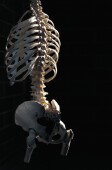
THURSDAY, March 7 (HealthDay News) — Older adults who get steroid injections for degeneration in their lower spine may fare worse than people who skip the treatment, a small study suggests.
The research, published recently in the journal Spine, followed 276 older adults with spinal stenosis in the lower back. In spinal stenosis, the open spaces in the spinal column gradually narrow, which can put pressure on nerves. The main symptoms are pain or cramping in the legs or buttocks, especially when you walk or stand for a long period.
The treatments range from “conservative” options like anti-inflammatory painkillers and physical therapy to surgery. People often try steroid injections before resorting to surgery. Steroids calm inflammation, and injecting them into the space around constricted nerves may ease pain — at least temporarily.
In the new study, researchers found that patients who got steroid injections did see some pain relief over four years. But they did not fare as well as patients who went with other conservative treatments or with surgery right away.
And if steroid patients eventually opted for surgery, they did not improve as much as surgery patients who’d skipped the steroids.
It’s not clear why, said lead researcher Dr. Kris Radcliff, a spine surgeon with the Rothman Institute at Thomas Jefferson University, in Philadelphia.
“I think we need to look at the results with some caution,” he said. Some of the study patients were randomly assigned to get steroid injections, but others were not — they opted for the treatment. So it’s possible that there’s something else about those patients that explains their worse outcomes, Radcliff said.
On the other hand, he said, steroid injections themselves might hamper healing in the long run. One possibility is that injecting the materials into an already cramped space in the spine might make the situation worse, once the initial pain-relieving effects of the steroids wear off, Radcliff explained.
“But that’s just our speculation,” he said.
A pain management specialist not involved in the work said it’s impossible to pin the blame on epidural steroids based on this study. For one, it wasn’t a randomized clinical trial, where all patients were assigned to have steroid injections or not have them, said Dr. Steven Cohen, a professor at Johns Hopkins School of Medicine, in Baltimore.
The patients who opted for epidural steroids “may have had more difficult-to-treat pain, or a worse pathology,” Cohen said.
He also noted that there is evidence from other research that epidural steroids can help some patients delay spine surgery.
“Epidural steroids won’t work for everyone, but they’re going to work for some people,” said Cohen, adding that he would “absolutely” suggest patients give them a shot if they want to put off surgery.
Epidural steroids should be seen as a “tool in the toolbox,” said Dr. Eric Mayer, of the Center for Spine Health at the Cleveland Clinic, in Ohio.
If the goal is to get some symptom relief and possibly delay surgery, then patients may want to try the injections, according to Mayer.
“This study is interesting,” he said. “But it really does nothing to inform medical practice.”
Epidural steroids have been the subject of some press recently. U.S. officials are currently investigating a deadly outbreak of fungal meningitis linked to epidural steroids produced by one Massachusetts pharmacy.
The patients in the current study came from 13 spine treatment centers in 11 U.S. states. Radcliff said there was no evidence of infections or other serious side effects from the treatment. “So, it did appear to be safe,” he said.
Radcliff said he wouldn’t discourage the use of steroid injections for patients who want to try them. “It’s still reasonable to offer this as an option,” he said. “These patients did improve; they just didn’t improve as much as the others.”
He also pointed out that spinal stenosis is just one cause of low back and leg pain. Other conditions can pinch a nerve and cause similar symptoms, such as a herniated disc.
Cohen said that in general, patients with a herniated disc respond better to steroid injections than those with spinal stenosis — though people with a herniated disc also have a good shot at getting better with no treatment.
Unlike a herniated disc, spinal stenosis is a progressive condition, and it won’t be “cured” with any treatment. Even after surgery, Cohen said, your symptoms may well come back at some point.
With epidural steroid injections, there’s no consensus on how long you can keep getting them.
But the general guideline is to have no more than three to six injections in a year, Cohen said — though that’s based on expert opinion rather than hard evidence. And just one injection at a time seems to be enough, Cohen noted. Some doctors are in the habit of doing three in one go, but there’s no evidence that it benefits patients.
If you do go for epidural steroid injections, it would be wise to make sure your insurance covers it: in the United States, one injection can cost a few hundred dollars.
The study was funded by the U.S. National Institutes of Health and the U.S. Centers for Disease Control and Prevention.
More information
Learn more about low back pain from the U.S. National Institute of Neurological Disorders and Stroke.

